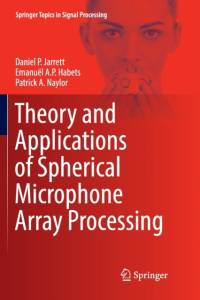Über Theory and Applications of Spherical Microphone Array Processing
This book presents the signal processing algorithms that have been developed to process the signals acquired by a spherical microphone array. Spherical microphone arrays can be used to capture the sound field in three dimensions and have received significant interest from researchers and audio engineers. Algorithms for spherical array processing are different to corresponding algorithms already known in the literature of linear and planar arrays because the spherical geometry can be exploited to great beneficial effect. The authors aim to advance the field of spherical array processing by helping those new to the field to study it efficiently and from a single source, as well as by offering a way for more experienced researchers and engineers to consolidate their understanding, adding either or both of breadth and depth. The level of the presentation corresponds to graduate studies at MSc and PhD level.This book begins with a presentation of some of the essential mathematical and physical theory relevant to spherical microphone arrays, and of an acoustic impulse response simulation method, which can be used to comprehensively evaluate spherical array processing algorithms in reverberant environments.The chapter on acoustic parameter estimation describes the way in which useful descriptions of acoustic scenes can be parameterized, and the signal processing algorithms that can be used to estimate the parameter values using spherical microphone arrays. Subsequent chapters exploit these parameters including in particular measures of direction-of-arrival and of diffuseness of a sound field. The array processing algorithms are then classified into two main classes, each described in a separate chapter. These are signal-dependent and signal-independent beamforming algorithms. Although signal-dependent beamforming algorithms are in theory able to provide better performance compared to the signal-independent algorithms, they are currently rarely used in practice. The main reason for this is that the statistical information required by these algorithms is difficult to estimate. In a subsequent chapter it is shown how the estimated acoustic parameters can be used in the design of signal-dependent beamforming algorithms. This final step closes, at least in part, the gap between theory and practice.
Mehr anzeigen

